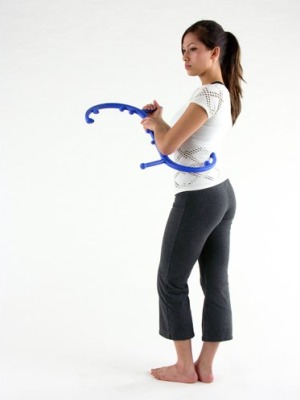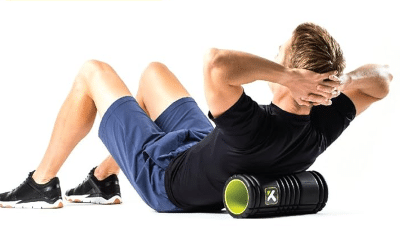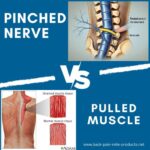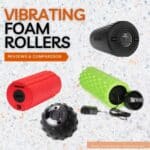Back muscle knots, also known as myofascial trigger points, are small, “bumpy” muscle areas that occur when muscle fibers or the bands of tissue called fascia underneath them tighten up, contract, and do not release.
These trigger points can irritate the nerves around them and cause referred pain anywhere horizontally or vertically in your lower body.
The good news is that you can speed up the healing of muscle knots naturally while relieving the pain almost immediately.
Here you’ll quickly find out the best ways to do that.
This post may contain affiliate links, at no extra cost to you.
Overview
How Do You Know If You Have a Muscle Knot in Your Back?
Muscle knots (hypertonicity) can usually be felt under the skin. When you press them, the pain gets worse.
Muscle knots are often a bit swollen and feel hard when you touch them.
If you have an active trigger point, the area causes pain even when you don’t touch it. If you have a latent trigger point, it is only painful when you press on it.
The most common area of muscle knots is the trapezius muscle, which starts in the neck and goes to the middle of the back and shoulders, forming a trapezium shape.
What Do Knots Look Like in Your Back?
Muscle knots can vary in size and severity.
Some may be small and barely noticeable, while others can be larger and swollen, which can make the area look more pronounced.
Their appearance also depends on their muscle group, muscle tone, and body composition.
Here’s what muscle knots look like in real life (instead of the common animations you find online):
What Causes Knots in Your Back?
Muscle knots are caused when a lower back muscle group is strained beyond being able to self-repair, so your body makes it contract and tighten up to avoid further use and more injury.
Common causes of muscle knots include:
- Poor posture (caused by sitting most of the day)
- Stress and tension
- Injuries (Improper weight lifting, or repetitive moves)
- Muscle spasms
- Too much bed rest or sitting without stretching
How Long Do Muscle Knots Last?
The duration of muscle knots varies depending on their severity and whether they are treated.
Acute knots may resolve within a few days with proper care (like doing some of the tips in this post), while chronic or severe knots can stay for weeks or months if left untreated.
Effective treatments, such as massage, heat therapy, or stretching, can speed up recovery significantly.
The 3 Quickest Ways to Release Muscle Knots (at Home)
I know the pain from a trigger point can be awful, but please consider letting go of the painkiller and try these natural and quick home treatments to loosen a muscle knot quickly.
Here’s how to get a knot out of your back by yourself:
1. Infrared Heating Pad

An infrared heating pad is probably the least known muscle knots reliever, yet the most effective one in my experience.
Why?
First, it’s highly effective.
For me, it works every time, and you’ll have trouble finding even one person claiming that an infrared heat pad hasn’t helped relieve their pain, any kind of pain, without medication.
Second, it requires you to do…absolutely nothing.
All you have to do is take a 30-minute nap while you’re on it. Or read a book. Or watch television.
While you’re enjoying your little break from life, the deeply penetrating and healing infrared rays will increase your blood circulation all the way to your bones and help your body un-knot your knots, naturally and safely.
My Infrared heating pad (I also have a full-body mat) has made my home much more popular in the last few years.
It can be used to relieve any type of pain, anywhere in your body, safely and naturally.
And, it has many other amazing uses (detox, weight loss, heart health, circulation problems, chronic illness, and more) which I’ve written about many times.
2. Trigger Point Self-Massage Tools

Using a self-massage tool for myofascial trigger points is proven to effectively relieve lower back knots – without any side effects.
Self-massage tools are easy to use, low-cost, and can be used at home whenever you need them.
The most popular ones are the Body Back Buddy and the Theracane, both recommended by physical therapists, massage therapists, and chiropractors.
Both of them have about 10 knobs on them, which you use to apply pressure to your trigger points, relax the muscle knots, and boost blood circulation to promote healing.
Both of them are lightweight and easy to use.
How Do You Use Self-Massage Tools to Release Trigger Points?
To release back muscle knots, you simply hook the Body Back Buddy or the Theracane over your shoulder or around your side and hold it by the handles so that the knob touches your trigger point.
Then you push away from your body with your lower or outside hand while guiding the knob with the upper or inside hand.
Stick with a comfortable pressure for 10 to 30 seconds and return to the treated area 3 to 4 times each session.
You may be shocked to see how fast you’ll feel better, and after a few sessions, you’ll be able to move better, use your muscles, and even drive pain-free.
3. Trigger Point Foam Roller
Unlike regular foam rollers, trigger point foam rollers are compact, heavy-duty foam rollers with different patterns on the surface for a variety of manipulations and applications.
They really put the regular foam rollers to shame. They won’t crumble apart after a few weeks of use, and they can really be helpful for your sore muscles.
They are the best way to break up muscle knots. Here’s how to use them:
Simply lie down on the roller and move around until you feel the pressure on your muscle knot. Roll over the painful area for about 30 seconds and repeat 3 times.
The Grid Foam Roller (my personal favorite) comes with a great guide on how to use it on different parts of the body, which is very helpful.
Here’s how to use a foam roller for muscle knots:
See my detailed review of the Grid Foam Roller
What Are Muscle Knots That Crunch With Massage?
According to some massage therapists, a muscle knot that feels like it “crunches” when massaged could be due to tight fascia (the connective tissue around muscles) slipping against adjacent tissues.
The sensation may also result from fascial adhesions or scar tissue, which can create friction as the tissue is manipulated.
Also, muscle knots often have reduced blood flow, which can lead to a buildup of metabolic waste. The crunchiness is more likely caused by stiffness or adhesions that require treatment to improve mobility and blood circulation.
How to Prevent Muscle Knots
Preventing back muscle knots starts with keeping good posture, especially if you spend long hours sitting or working at a desk.
Make sure your work chair has good lumbar support, keep your feet flat on the ground, and adjust your computer screen to eye level to avoid straining your neck and shoulders.
Get used to taking regular breaks to stand up, stretch, and move around. Stretches like shoulder rolls, chest openers, and seated spinal twists can keep your back muscles flexible and reduce tension.
Your sleep routine is also crucial for muscle recovery and repair, so aim for 7-9 hours per night, and use back and neck supporting pillows and a good mattress for back pain prevention.
To your health and happiness,
The Back Pain Relief Products Team



